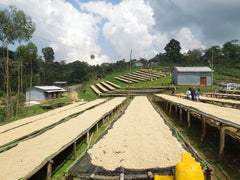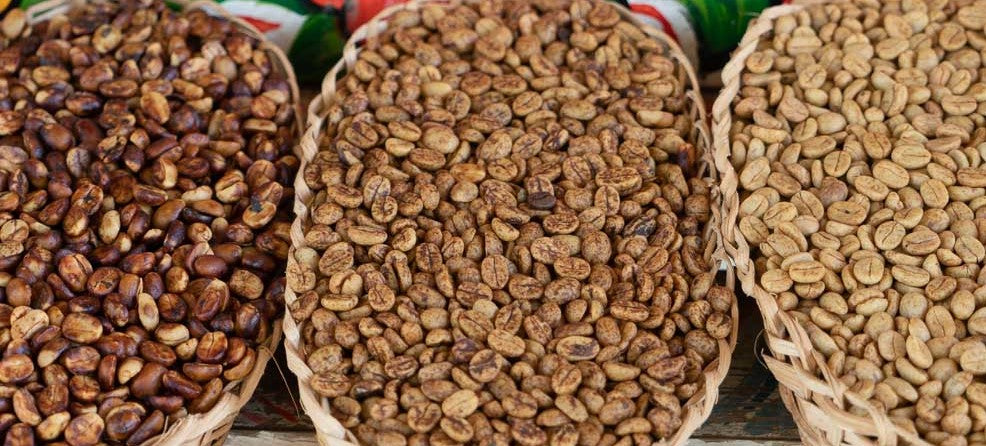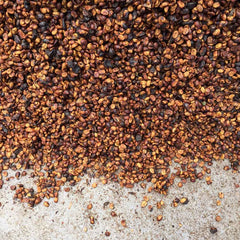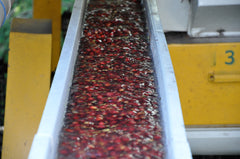NO BEES TO SEE HERE!
A common question we get when we have a coffee that is honey processed is whether there is actually honey and bees involved! The answer is a simple no. So, what is this honey process, what does it involve, why the use of the word ‘honey’ and does it make a difference to the end result in how the coffee tastes when you drink it?
DOES COFFEE NEED TO BE PROCESSED?
YES! All coffees need to be processed. This is because the coffee seed needs to be separated from the cherry fruit and mucilage before it becomes the green coffee bean that we then take and roast. There are different processes that are used in the coffee farming industry and a lot of the time it is the origin’s climate and natural resources that dictate which method would be commonly used.
The most common (and fastest) process is washed or fully washed and its pretty self-explanatory – water is used to ‘wash’ the cherries in order to remove the fruit from the seed before drying.

THE HONEY PROCESS
The honey process is a relatively recent process mainly adopted by coffee producing countries in the Central Americas. In particular, Costa Rica is now widely known for its honey processed coffees and as you may know, we love Costa Rican coffees (you can check our blog on Costa Rica here: https://quantumroasters.co.uk/blogs/news/origin-costa-rica )
This process is often seen as a hybrid between natural and washed processes and is also similar to the pulped natural process a technique used a lot in Brazil. Irrespective of which process is used, the bottom line is, that the cherries need to be milled or hulled to remove the last layers that protect the bean inside.
With the honeys, a machine is used for de-pulping. What this does, is, it removes the outer skin and some of the mucilage from the cherries. The type of honey process achieved depends on how much of the mucilage is removed.
Here are the ‘types’ of honeys you can get:

White honey – this has the least amount of mucilage remaining
Yellow honey
Red honey
Black honey – this has 100% of mucilage remaining
Another big difference between the types of honeys is the drying time and the techniques used during the drying process.
The term ‘honey’ is used because of the mucilage that remains; its sticky and rich in sugar, reminiscent of real bee making honey! This sugar rich mucilage also translates into some sweetness in the cup when eventually drank as a beverage.
BLACK HONEY – WHY SO SPECIAL?
 Black honey is considered, and I agree, the most complex, arduous and difficult process. This is mainly due to the long fermentation time (up to twice as long compared to yellow and red honey processing!) and it takes up a lot of space on the drying beds.
Black honey is considered, and I agree, the most complex, arduous and difficult process. This is mainly due to the long fermentation time (up to twice as long compared to yellow and red honey processing!) and it takes up a lot of space on the drying beds.
The complexity and difficulty of the black honey process is risky business for coffee farmers. Why? Because the beans are left with pretty much all the mucilage on, they are surrounded by sugar and microorganisms whilst they are drying which means they need to be laid out in thin layers to avoid mould and quick fermentation.
 Black honeyed coffee takes up to 15 days to dry. During this time, these thin layers need to be agitated, rotated, airated and raked out regularly in order to control fermentation. This takes a lot of hard work and time. Shade is also important and in Costa Rica they dry the beans in green houses. Using green houses also keeps the random rains away which would also ruin the fermentation process. This process however has the benefit of using little water compared to washed coffees where a large amount of water is used in their processing.
Black honeyed coffee takes up to 15 days to dry. During this time, these thin layers need to be agitated, rotated, airated and raked out regularly in order to control fermentation. This takes a lot of hard work and time. Shade is also important and in Costa Rica they dry the beans in green houses. Using green houses also keeps the random rains away which would also ruin the fermentation process. This process however has the benefit of using little water compared to washed coffees where a large amount of water is used in their processing.
IS IT WORTH IT?
Definitely YES! For producers, particularly in Costa Rica, where they are known for their honey processes and are pioneers, the ability to be able to regulate and control the whole fermentation process is worth the risk because they truly care about the quality of their coffee and believe in the process. For the roaster, a challenge to do the coffee justice and for the consumer…well, tasty pleasure!
Black honey processed coffees we believe are a true specialty coffee even before they get to be roasted. Costa Rica, for us is the true expert in the process.
So, we are giving you the opportunity to try both a red honey Costa Rican coffee and a Black Honey one.
Take your pick and grab a bag, brew a cup and enjoy!
https://quantumroasters.co.uk/collections/new-arrivals/products/costa-rica-las-lajas-black-honey-coffee https://quantumroasters.co.uk/collections/central-america/products/costa-rica-coope-dota



